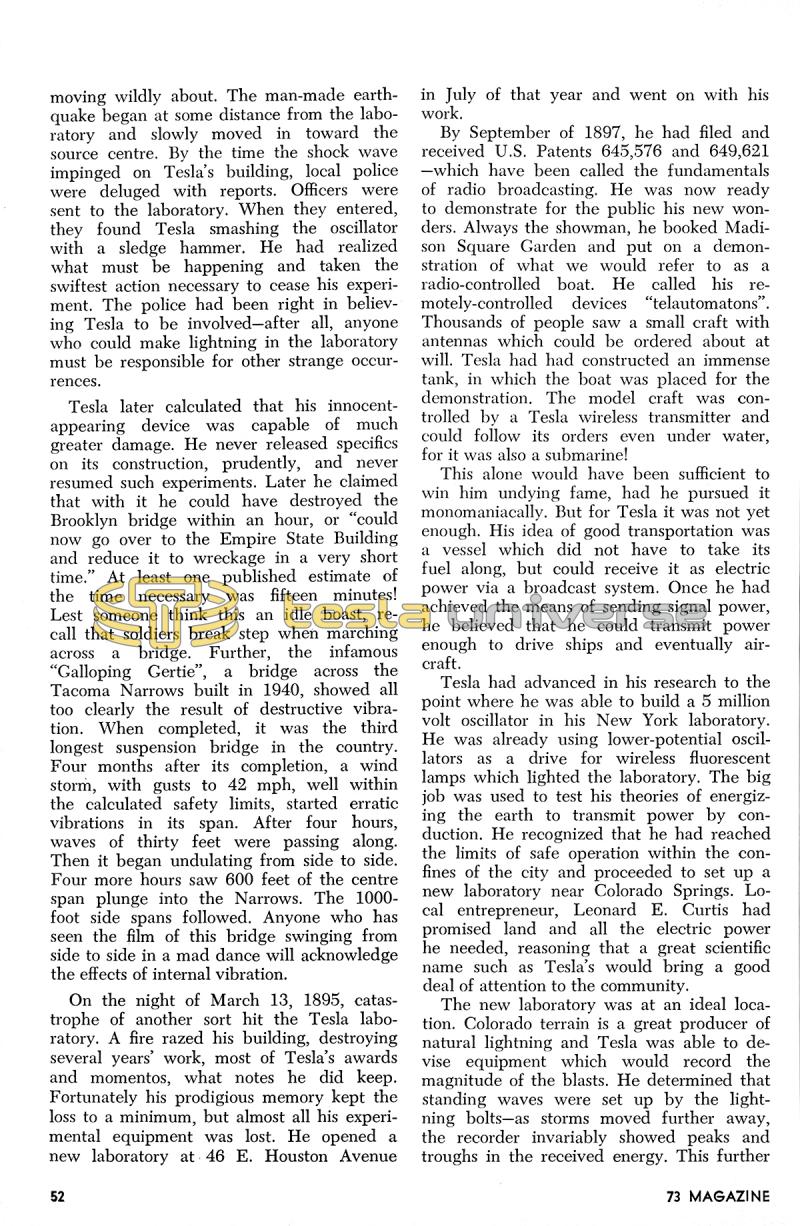
Nikola Tesla Articles
moving wildly about. The man-made earthquake began at some distance from the laboratory and slowly moved in toward the source centre. By the time the shock wave impinged on Tesla's building, local police were deluged with reports. Officers were sent to the laboratory. When they entered, they found Tesla smashing the oscillator with a sledge hammer. He had realized what must be happening and taken the swiftest action necessary to cease his experiment. The police had been right in believing Tesla to be involved - after all, anyone who could make lightning in the laboratory must be responsible for other strange occurrences.
Tesla later calculated that his innocent-appearing device was capable of much greater damage. He never released specifics on its construction, prudently, and never resumed such experiments. Later he claimed that with it he could have destroyed the Brooklyn bridge within an hour, or "could now go over to the Empire State Building and reduce it to wreckage in a very short time." At least one published estimate of the time necessary was fifteen minutes! Lest someone think this an idle boast, recall that soldiers break step when marching across a bridge. Further, the infamous "Galloping Gertie", a bridge across the Tacoma Narrows built in 1940, showed all too clearly the result of destructive vibration. When completed, it was the third longest suspension bridge in the country. Four months after its completion, a wind storm, with gusts to 42 mph, well within the calculated safety limits, started erratic vibrations in its span. After four hours, waves of thirty feet were passing along. Then it began undulating from side to side. Four more hours saw 600 feet of the centre span plunge into the Narrows. The 1000-foot side spans followed. Anyone who has seen the film of this bridge swinging from side to side in a mad dance will acknowledge the effects of internal vibration.
On the night of March 13, 1895, catastrophe of another sort hit the Tesla laboratory. A fire razed his building, destroying several years' work, most of Tesla's awards and momentos, what notes he did keep. Fortunately his prodigious memory kept the loss to a minimum, but almost all his experimental equipment was lost. He opened a new laboratory at 46 E. Houston Avenue 52 in July of that year and went on with his work.
By September of 1897, he had filed and received U.S. Patents 645,576 and 649,621 - which have been called the fundamentals of radio broadcasting. He was now ready to demonstrate for the public his new wonders. Always the showman, he booked Madison Square Garden and put on a demonstration of what we would refer to as a radio-controlled boat. He called his remotely-controlled devices "telautomatons". Thousands of people saw a small craft with antennas which could be ordered about at will. Tesla had had constructed an immense tank, in which the boat was placed for the demonstration. The model craft was controlled by a Tesla wireless transmitter and could follow its orders even under water, for it was also a submarine!
This alone would have been sufficient to win him undying fame, had he pursued it monomaniacally. But for Tesla it was not yet enough. His idea of good transportation was a vessel which did not have to take its fuel along, but could receive it as electric power via a broadcast system. Once he had achieved the means of sending signal power, he believed that he could transmit power enough to drive ships and eventually aircraft.
Tesla had advanced in his research to the point where he was able to build a 5 million volt oscillator in his New York laboratory. He was already using lower-potential oscillators as a drive for wireless fluorescent lamps which lighted the laboratory. The big job was used to test his theories of energizing the earth to transmit power by conduction. He recognized that he had reached the limits of safe operation within the confines of city and proceeded to set up a new laboratory near Colorado Springs. Local entrepreneur, Leonard E. Curtis had promised land and all the electric power he needed, reasoning that a great scientific name such as Tesla's would bring a good deal of attention to the community.
The new laboratory was at an ideal location. Colorado terrain is a great producer of natural lightning and Tesla was able to devise equipment which would record the magnitude of the blasts. He determined that standing waves were set up by the lightning bolts-as storms moved further away, the recorder invariably showed peaks and troughs in the received energy. This further
